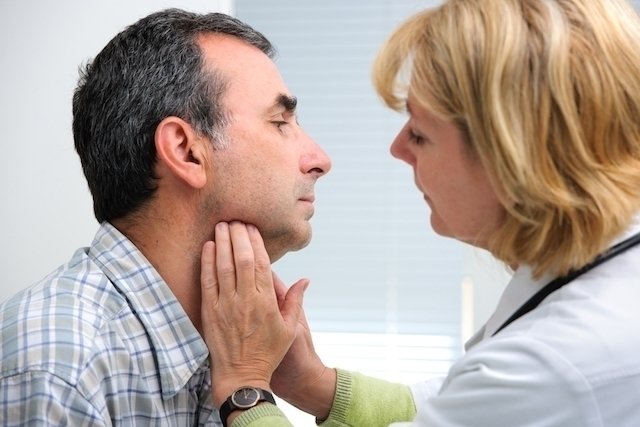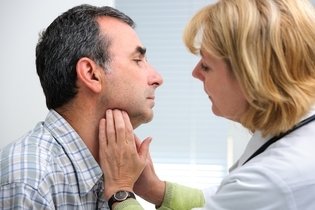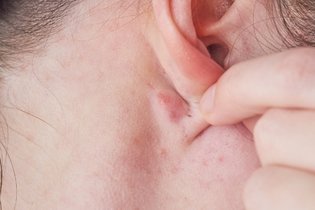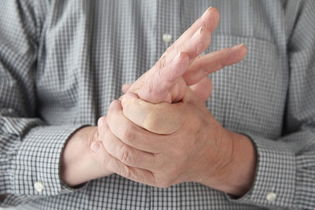Lymph nodes are small, bean-like, glands that play a very important role in immunity. They filter the lymph fluid, which removes the virus and bacteria that can be cause an infection. Once removed, these micro-organisms are destroyed by lymphocytes, which are the immune cells present inside the lymph nodes.
Lymph nodes are located throughout the body, in groups. They are found in places such as the the neck, underarms and groin area. Each group is responsible for helping to fight infections that develop nearby, and will often become reactive, or swollen, in the presence of infections.
Lymph nodes can become reactive from mild problems, such as a skin infection or UTI, or from more serious conditions, such as cancer.

What can cause swollen lymph nodes
Lymph nodes become swollen from local trauma or infection, therefore the doctor should carefully assess the area to reach a diagnosis. About 80% of swollen lymph nodes in people under 30 years old are due to local infections, but they can also have other causes:
1. In the neck
The lymph nodes in the neck can swell on sides of the neck, but also under the jaw or near the ears. When that happens you may feel, or even see, a small lump in those areas. Swollen lymph nodes in the neck or lower face can be a sign of:
- A tooth abscess
- A thyroid cyst
- Changes in the salivary glands
- Inflamed throat
- Pharyngitis or laryngitis
- Cut or bite mark in the mouth
- Mumps
- Ear or eye infection
In more rare situations, swollen lymph nodes in the neck may also signal a tumor in the region, such as the throat, larynx or thyroid.
2. In the groin
Lymph nodes in the groin may also become swollen due to infection or trauma to the legs, feet or genital area. One of the most common causes are urinary tract infections, but it can also happen after a genital surgical procedure or due to a sexually transmitted infection. In rarer cases, swollen lymph nodes in the groin can also be a sign of cancer in the genital area, such as vulvar cancer, vaginal cancer or penile cancer.
3. In the armpit
The most common causes of swollen axillary lymph nodes are wounds or infections in the hands, arms, or axilla, an ingrown hair or furunculosis (a boil). However, this type of swelling can also be a sign of a more serious problem, such as lymphoma, especially if you experience fever and sweating and night. Other situations such as animal bites, brucellosis, sporotrichosis and breast cancer can also cause swollen axillary lymph nodes.
Cancer is relatively rare, and the presence of a swelling in the armpit area is often related to swollen lymph nodes, but rather a cyst or a lipoma, which are easy to treat. Therefore, if you have swollen lymph nodes that do not improve, you should see your doctor for assessment.
4. In the clavicle
Lumps in the upper part of the clavicle may indicate infections, lymphoma, lung, breast, neck or stomach cancer. If the gland in the left supraclavicular area feels hard and fixed, this may indicate gastrointestinal neoplasia, and it is known as a Virchow Node.
5. Throughout the body
Even though it is more common for lymph nodes to swell up in one specific area, they can also happen systemically, all over the body. This is usually related to diseases, such as:
- Autoimmune diseases,
- Lymphoma
- Leukemia
- Cytomegalovirus
- Mononucleosis
- Secondary syphilis
- Sarcoidosis
- Systemic lupus erythematosus
- Hyperthyroidism
- Side-effects of medication such as Hydantoin, antithyroid agents and isoniazid.
6. In the back of the head
Little lumps on the back of the head may indicate the scalp infections, rubeola or even insect bites. Even though it is rare, this type of lump may also happen due to cancer.
7. Near the ears
Swollen lymph nodes near the ears may indicate conditions such as rubella, eyelid infections or conjunctivitis.
When can swollen lymph nodes be cancer
Swollen lymph nodes are almost always a sign of an infection. However, there are some cases in which the swelling may happen due to cancer. The only way to be sure is by seeing a doctor and completing testing like blood tests, a biopsy and a CT.
A physical assessment of the swollen lymph nodes can help to identity the underlying cause. The doctor will often palpate the glands to evaluate whether they are fixed or moveable, and to get an idea of size and associated discomfort. Painful glands have a fewer chance of being related to cancer.
The risk of a swollen lymph node being cancer is greater when the swelling persists for more than 6 weeks and occurs with other symptoms, such as:
- Various swollen lymph nodes throughout the body
- Hardened consistency
- Absence of pain when touching the lumps
- Burning sensation
In addition, age is also an important factor because people over 50 have a higher probability of developing cancer. If the doctor is unsure and a confirmation is required, the doctor may request a needle aspiration biopsy of the lymph node to check if there are cancerous cells present.
Some neoplastic diseases that also cause swollen glands are lymphoma, leukemia, and breast, lung, kidney, prostate, skin, head and neck, gastrointestinal tract metastasis and germinative cell tumors.
When to see the doctor
Most cases of swollen lymph nodes do not require treatment, as they will often resolve in less than one week. You should see your doctor, however, if you experience any of the following:
- Lymph nodes remain swollen for over three weeks
- There is no pain when touching the swollen lymph node
- The lump increases in size with time
- You have weight loss with no apparent caus
- Other symptoms appear such as fever, fatigue, weight loss and night sweats appear
- Swollen lymph nodes appear in other areas of the body.
In these cases, the doctor may prescribe several tests including bloodwork to try to identify the cause, depending on the lymph nodes that were affected. Adequate treatment can will be initiated based on results.








